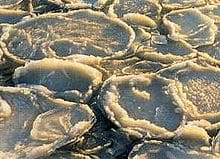At the right temperature, on the underside of the freezing point, salt water turns into a syrupy slush. Then thin sheets of ice begin to form on the surface. They grow thicker with time, covering larger and larger areas, until wave action breaks them up into smaller, odd angular shapes.
As these shapes congregate with each other, bumping into each other, over and over again, spinning slowly, followed by more bumping, these irregular ice sheets slowly transform into rounded shapes. Like character development, the more time a community of individual ice sheets spends interacting with each other, the more well rounded they each become.
The result: pancakes by the dozens. Hundreds. Thousands.
You’ll often see classic pancakes floating in sheltered, New England harbors. Stroll down T-Wharf in Rockport, Mass., on a frigid winter day and you’ll notice the icy Johnnycakes that form there. (Don’t forget your camera; the ever inspiring, albeit rebuilt, Motif #1 still graces Rockport’s diminutive anchorage.)
Out at sea, though, is where you’ll find the real pancake smorgasbord being served up. Imagine hundreds of square miles of ocean polka dotted with millions of closely clustered, frozen disks; their edges cupped with ice crystals that splash onto the cakes as they knock against each other.
While pancake ice comes in sizes ranging from a few inches to 10 feet in diameter, it rarely grows much thicker than four or five inches. Still, a 10-foot diameter pancake is about 25 cubic feet of ice weighing about 1,400 pounds. So unless you’re really outgoing, gregarious, and masterful at breaking the ice, you might want to avoid bumping into the crowd at the pancake fest.

